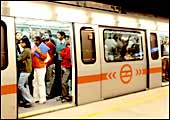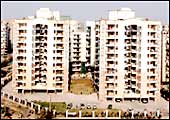 |
 |
 |
| 1. Jostling in: Commuters on the Barakhamba-Dwarka
line. Apparently, 5 lakh passengers ride up and down this
line every day
2. Kolkata Metro: India's first, but upstaged by Delhi's
more modern metro
3. Booming West Delhi: Real estate prices have soared in
Dwarka
|
NEW DELHI
January 19, 3 p.m.
Ever
since prime minister Manmohan Singh inaugurated late last month
Delhi Metro's Line 3 that connects Barakhamba in the heart of
capital's Connaught Place and Dwarka, arguably Asia's largest
housing colony in the western outskirts of the city, there has
been a spate of VIP joy rides on Delhi Metro Rail. The list includes
Japanese Minister for Foreign Affairs, Taro Aso, Ireland's Prime
Minister Bertie Ahern, the judges of Supreme Court, including
Chief Justice Y.K. Sabharwal, and Delhi Chief Minister Sheila
Dikshit.
As a business reporter, my interest in the
metro goes beyond its novelty (besides, Metro's phase I is three
years old now). I want to find out just how much has India's showcase
project transformed lives of people in the capital. There's only
one way to find out. I decide to take a ride on the newly opened
section to and from Dwarka. My boarding station: Jhandewalan,
which is a two-minute walk from my office. First impressions:
The escalator at the station isn't working yet and some final
finishing work is still going on, but the platform itself is neat
and clean.
I haven't been waiting for more than three
minutes when the Korean-built rolling stock glides into the station.
There's an assortment of passengers waiting to board at Jhandewalan
this Friday afternoon: school children, housewives, junior executives,
and men who look like petty traders. The train doors open, and
a gaggle of men, women, children spills out on to the platform.
I get in and choose to stand in one corner since that gives me
a 360-degree view.
Cutting through the heart of West Delhi and
stopping for an average of 20 seconds at each of the 20 stations
in between, the electric train puts me at Dwarka's sector 15 terminal
station in all of 40 minutes. During the journey I've been chatting
up a few co-passengers like D Murli, an agency officer at ICICI
Prudential, located in the same building where my office is. He
tells me that commuting has become a pleasure after the Metro
opened. Earlier it would take him anywhere between an hour-and-a-half
and two hours to reach Janakpuri from Connaught Place either by
car or bus. Now it takes less than 20 minutes.
To me, it's evident that the Metro is changing
or will change Delhi (In fact, it's impacting the rest of the
country too; I'll come to that in a bit). Over the past decade,
the capital city had lost out to suburbs like Gurgaon, Noida and
Greater Noida, all of which have been transformed by a boom in
real estate developments. A whole lot of it companies, BPOs and
MNCs shifted to or set up their offices in Gurgaon and Noida,
and a residential boom had blossomed alongside in these suburbs.
By contrast, Delhi hardly saw any new residential development,
except for Dwarka, which had a low 20 per cent occupancy until
last year. As for commercial projects, only a couple of them are
coming up in select areas like Saket and Vasant Kunj.
That may be about to change. As the Metro
line neared completion, Dwarka's occupancy doubled to 40 per cent
in the last few months, while real estate prices shot up by more
than 30 per cent. "The price of a Rs 25-lakh apartment has
gone up to Rs 30 lakh in Dwarka in the last two or three months
alone," says Sandeep Saini, a local real estate broker. "Once
the metro line extends to the heart of Dwarka, expected by March,
the prices will shoot up another Rs 5 lakh to 10 lakh," he
says.
But the biggest impact of Metro is retail
development and it's happening across all the major centres like
Janakpuri, Shivaji Place, Jasola and Shahadra in the Delhi Metro
corridor. For instance, Janak Place (the Janakpuri commercial
complex owned by Delhi Development Authority) had been lying neglected
for years due to a lack of retail interest. "Now we see a
lot of action there," says Aniruddh Wahal, Associate Director,
Jones Lang Lasalle, a real estate consultancy. He adds it's likely
that BPOs and it firms may look at setting up shop in these metro
corridors, since it's far cheaper than running operations in Gurgaon
and Noida. "Shahadra is a great destination for a BPO. It's
well-connected to Delhi University and also Noida," he says.
Plus, BPOs can save on transport costs, which, in Gurgaon, is
equal to the real estate costs.
Phase I of Delhi Metro has three lines: a
Blue Line that connects Barakhamba Road with Dwarka; Yellow runs
between Central Secretariat and Delhi University's North Campus,
and Red connects Shahadra in East Delhi to Rithala in North. The
Red Line will be fully operational by March. The plan is to have
245 kilometres of rail network (consisting of 8 lines) within
Delhi by 2021. Then, it is expected to carry 10.8 million people
per day. It's going to be a great respite for commuters of Delhi,
which adds about 600 cars a day.
Delhi Metro's success has ignited interest
in other big cities too. Kolkata and Delhi apart, there are six
cities where the population is more than three million and an
MRTs is planned. Chennai, Hyderabad, Bangalore, Ahmedabad and
Mumbai have approached Delhi Metro for preparing detailed project
reports for metro systems. The work on Bangalore's proposed 36.5-kilometre
metro rail network may begin anytime now (25 construction companies
have been shortlisted), and is expected to be completed in five
years. (Even countries like Sri Lanka, Indonesia and Bangladesh
have approached DMRC for help.)
So, it's quite possible that in another 30
years or so, India's big cities start looking world class. Now,
that's something.
|






